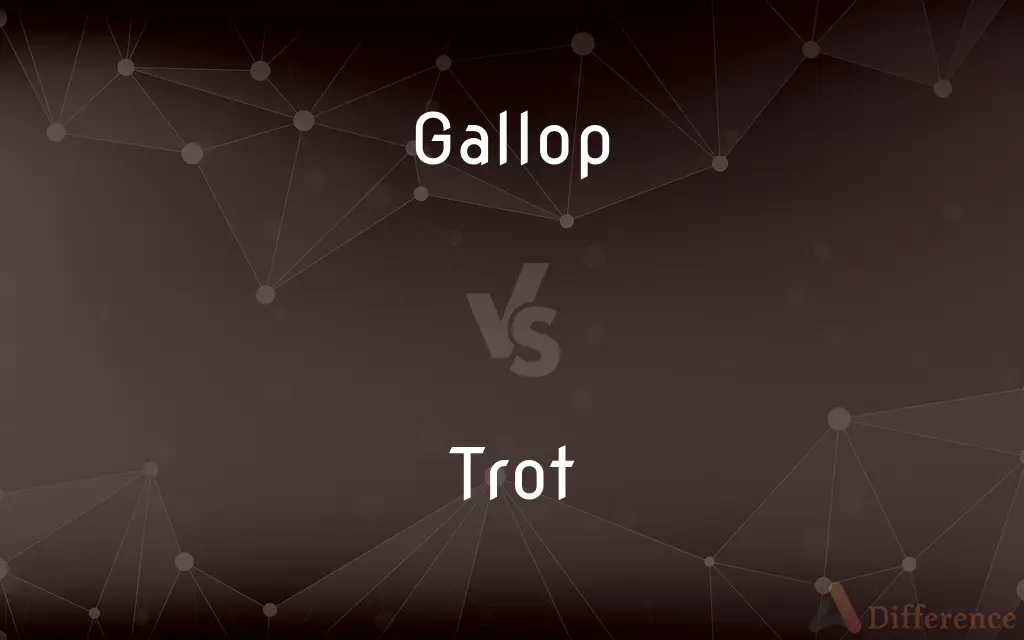Gallop vs. Trot — What's the Difference?
By Tayyaba Rehman & Maham Liaqat — Updated on April 4, 2024
Gallop involves a faster, four-beat rhythm where all four hooves leave the ground, whereas trot is a slower, two-beat gait with diagonal pairs of hooves striking the ground together.

Difference Between Gallop and Trot
Table of Contents
ADVERTISEMENT
Key Differences
Gallop is characterized by its speed and the sequence in which a horse's hooves touch the ground, offering a moment when all four hooves are airborne. This gait is most commonly seen in racing and situations requiring high speed. On the other hand, trot is significantly slower, marked by a rhythmic two-beat pattern where diagonal pairs of hooves hit the ground simultaneously. It's a common gait for training and warming up horses due to its steadiness and balance.
While galloping, a horse can reach its top speed, showcasing the animal's full capacity for swift movement. This gait is often associated with excitement, escape, or competitive scenarios. Conversely, trotting is employed for endurance, training, and leisure riding, emphasizing control, rhythm, and the development of a horse's physical condition.
The energy exerted in a gallop is considerably higher than in a trot, with the former being sustainable for shorter durations due to its intensity. Trotting, whereas, can be maintained for longer periods, making it ideal for travel over moderate distances without exhausting the horse.
In galloping, the rider experiences a more dynamic motion, requiring skilled balance and handling to manage the rapid, airborne phases of the gait. Trotting, on the other hand, demands a synchronized movement with the horse, focusing on rhythm and posture to facilitate a smooth ride.
Galloping and trotting also serve different purposes in equestrian training and competitions. Galloping is essential in races and cross-country events, where speed is crucial. Trotting, however, is fundamental in dressage and show jumping, where precision and the horse’s ability to move gracefully are judged.
ADVERTISEMENT
Comparison Chart
Beat Pattern
Four-beat
Two-beat
Hooves Airborne
Yes
No
Speed
Fast
Moderate
Usage
Racing, escaping
Training, leisure
Rider Skill
Advanced
Intermediate
Compare with Definitions
Gallop
To proceed or act very quickly.
He galloped through his homework to meet his friends.
Trot
A moderate speed for horses, between a walk and a canter.
They enjoyed a leisurely trot through the countryside.
Gallop
A fast gait of a horse where all four feet are off the ground simultaneously.
The horse broke into a gallop as it neared the finish line.
Trot
A term for moving at a moderately fast pace.
She trotted over to answer the door.
Gallop
The fastest speed at which a horse can move.
The rider urged her horse into a full gallop.
Trot
To cause to move in this gait.
She trotted her pony around the arena.
Gallop
A mode of running for some animals, distinct for its speed.
The cheetah can gallop faster than any other land animal.
Trot
A two-beat gait of a horse, moving diagonal legs together.
The rider slowed her horse to a trot.
Gallop
Symbolic of freedom or rapid progress.
The startup's growth went at a gallop, surprising many.
Trot
Used to describe steady and continuous work or activity.
He's been on a trot with his project deadlines.
Gallop
The fastest pace of a horse or other quadruped, with all the feet off the ground together in each stride
A mounted police charge at full gallop
The horse broke into a furious gallop
Trot
The trot is a two-beat diagonal gait of the horse where the diagonal pairs of legs move forward at the same time with a moment of suspension between each beat. It has a wide variation in possible speeds, but averages about 13 kilometres per hour (8.1 mph).
Gallop
(of a horse) go at the pace of a gallop
We galloped along the sand
Trot
The gait of a horse or other four-footed animal, between a walk and a canter in speed, in which diagonal pairs of legs move forward together.
Gallop
Proceed at great speed
Don't gallop through your speech
Trot
A ride on a horse moving with this gait.
Gallop
A gait of a horse, faster than a canter, in which all four feet are off the ground at the same time during each stride.
Trot
A gait of a person, faster than a walk; a jog.
Gallop
A fast running motion of other quadrupeds.
Trot
(Sports) A race for trotters.
Gallop
A ride taken at a gallop.
Trot
See pony.
Gallop
A rapid pace
Events were proceeding at a gallop.
Trot
Trots(Informal) Diarrhea. Used with the.
Gallop
(Medicine) A disordered rhythm of the heart characterized by three or four distinct heart sounds in each cycle and resembling the sound of a galloping horse. Also called gallop rhythm.
Trot
A toddler.
Gallop
To cause to gallop.
Trot
(Archaic) An old woman.
Gallop
To go or move at a gallop.
Trot
To go or move at a trot.
Gallop
To move or progress swiftly
Summer was galloping by.
Trot
To proceed rapidly; hurry.
Gallop
The fastest gait of a horse, a two-beat stride during which all four legs are off the ground simultaneously.
Trot
To cause to move at a trot.
Gallop
An act or instance of going or running rapidly.
Trot
An ugly old woman, a hag.
Gallop
(cardiology) An abnormal rhythm of the heart, made up of three or four sounds, like a horse's gallop.
Trot
A gait of a four-legged animal between walk and canter, a diagonal gait (in which diagonally opposite pairs of legs move together).
Gallop
To run at a gallop.
The horse galloped past the finishing line.
Trot
A gait of a person or animal faster than a walk but slower than a run.
Gallop
(intransitive) To ride at a galloping pace.
Trot
A brisk journey or progression.
We often take the car and have a trot down to the beach.
In this lesson we'll have a quick trot through Chapter 3 before moving on to Chapter 4.
Gallop
(transitive) To cause to gallop.
To gallop a horse
Trot
A toddler.
Gallop
(ambitransitive) To make electrical or other utility lines sway and/or move up and down violently, usually due to a combination of high winds and ice accrual on the lines.
Trot
(obsolete) A young animal.
Gallop
(intransitive) To run very fast.
Trot
(dance) A moderately rapid dance.
Gallop
To go rapidly or carelessly, as in making a hasty examination.
Trot
A succession of heads thrown in a game of two-up.
Gallop
To progress rapidly through the body.
Trot
A run of luck or fortune.
He′s had a good trot, but his luck will end soon.
Gallop
To move or run in the mode called a gallop; as a horse; to go at a gallop; to run or move with speed.
But gallop lively down the western hill.
Trot
Synonym of horse}} {{gloss
Gallop
To ride a horse at a gallop.
Trot
Diarrhoea.
He's got a bad case of the trots and has to keep running off to the toilet.
Gallop
Fig.: To go rapidly or carelessly, as in making a hasty examination.
Such superficial ideas he may collect in galloping over it.
Trot
A genre of Korean pop music employing repetitive rhythm and vocal inflections.
Gallop
To cause to gallop.
Trot
(intransitive) To move along briskly; specifically, to move at a pace between a walk and a run.
I didn't want to miss my bus, so I trotted the last few hundred yards to the stop.
The dog trotted along obediently by his master's side.
Gallop
A mode of running by a quadruped, particularly by a horse, by lifting alternately the fore feet and the hind feet, in successive leaps or bounds.
Trot
To move at a gait between a walk and a canter.
Gallop
A fast gait of a horse; a two-beat stride during which all four legs are off the ground simultaneously
Trot
(transitive) To cause to move, as a horse or other animal, in the pace called a trot; to cause to run without galloping or cantering.
Gallop
Ride at a galloping pace;
He was galloping down the road
Trot
To bid against (a person) at an auction, so as to raise the price of the goods.
Gallop
Go at galloping speed;
The horse was galloping along
Trot
Fig.: To run; to jog; to hurry.
He that rises late must trot all day, and will scarcely overtake his business at night.
Gallop
Cause to move at full gallop;
Did you gallop the horse just now?
Trot
To cause to move, as a horse or other animal, in the pace called a trot; to cause to run without galloping or cantering.
Trot
The pace of a horse or other quadruped, more rapid than a walk, but of various degrees of swiftness, in which one fore foot and the hind foot of the opposite side are lifted at the same time.
Trot
Fig.: A jogging pace, as of a person hurrying.
Trot
One who trots; a child; a woman.
An old trot with ne'er a tooth.
Trot
A slow pace of running
Trot
Radicals who support Trotsky's theory that socialism must be established throughout the world by continuing revolution
Trot
A literal translation used in studying a foreign language (often used illicitly)
Trot
A gait faster than a walk; diagonally opposite legs strike the ground together
Trot
Run at a moderately swift pace
Trot
Ride at a trot
Trot
Cause to trot;
She trotted the horse home
Common Curiosities
Can all horses trot and gallop?
Yes, all healthy horses are capable of both trotting and galloping, although the ease and speed at which they do so can vary.
Which gait is more sustainable over long distances?
Trotting is more sustainable over long distances compared to galloping, which is best reserved for short bursts.
Is galloping faster than trotting?
Yes, galloping is significantly faster and is the fastest gait of a horse.
How do jockeys influence a horse's gait during a race?
Jockeys use body weight, reins, and verbal cues to influence a horse’s speed, direction, and when to change gaits.
What distinguishes a gallop from a trot?
A gallop is a fast, four-beat gait with a phase of suspension, while a trot is a slower, two-beat gait with diagonal legs moving together.
Why is trotting important in horse training?
Trotting helps develop a horse's balance, rhythm, and muscular strength, serving as a foundation for more advanced gaits.
Can trotting be uncomfortable for the rider?
Yes, without proper technique, trotting can be bouncy and uncomfortable, requiring practice to sit smoothly.
How does a rider control a horse at a gallop?
Through skilled balance, proper posture, and experienced use of reins and leg commands.
What equipment might a rider need for galloping?
A secure saddle, stirrups for proper positioning, and a helmet for safety are essential for galloping.
Are there different types of gallops?
While the term primarily refers to the fastest gait, variations can occur based on speed, stride length, and the horse's style.
Why might a rider choose to trot instead of gallop?
Trotting is chosen for control, endurance training, and when speed is not the primary objective.
What is a trot used for in competitions?
In competitions, trotting is used in dressage and show jumping for demonstrating precision, grace, and the horse's training level.
What is the difference in hoof patterns between a trot and a gallop?
In trotting, diagonal pairs of hooves land together, while in galloping, there's a distinct four-beat pattern with a moment of suspension.
How do you teach a horse to trot or gallop?
Through gradual training, using cues to encourage the desired gait while ensuring the horse is balanced and responsive.
Share Your Discovery

Previous Comparison
Physician vs. Clinician
Next Comparison
Context vs. AbstractAuthor Spotlight
Written by
Tayyaba RehmanTayyaba Rehman is a distinguished writer, currently serving as a primary contributor to askdifference.com. As a researcher in semantics and etymology, Tayyaba's passion for the complexity of languages and their distinctions has found a perfect home on the platform. Tayyaba delves into the intricacies of language, distinguishing between commonly confused words and phrases, thereby providing clarity for readers worldwide.
Co-written by
Maham Liaqat













































